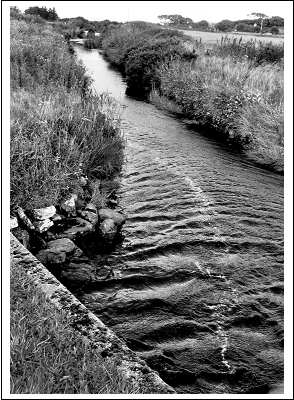 | Caithness.Org | Community | Business | Entertainment | Caithness... | Tourist Info | Site Map |
• Advertising • Chat Room • Contact Us • Kids Links • Links • Messageboard • News - Local & Scottish • News - UK & News Links • About / Contact Us • Submissions |
• Bookshop • Business Index & News • Jobs • Property For Sale • Property For Rent • Shop • Sutherland Business Index |
• Fishing • Fun Stuff • George, The Saga • Horses • Local Galas • Music • Pub Guide • Sport Index • What's On In Caithness |
• General Information • B & Bs • Backpackers • Caravan & Camping • Ferries • Getting Here • Holiday Letting • Hotels • Orkney • Pentland Firth • Sutherland • Taxis |
| N E W S F E E D S >>> |
|
Caithness Field Club Bulletin |
| Telfords Mill Lade at Wick (by
Jenny Bruce) Background Telford�s Mill Lade
Although Telford had taken the levels of Loch Hempriggs in 1804 and seen that the water could be transported with ease, it was not until March 1807 that the feu contract was completed between the British Fisheries Society and the landowner, Sir Benjamin Dunbar. One condition of the contract was that the new watercourse should also supply the corn and barley mills of the Dunbar estate. In July 1807 development started on the construction of the harbour, town, main bridge and the watercourse. The lade channel is constructed exactly as stated in Telford�s original letters using Caithness slate laid in horizontal dyking and is still in use today. Drainage from adjacent fields does not pollute the course as all surplus water runs into underground culverts below the level of the channel � another of Telford�s ingenious concepts. The rise on the surrounding ground also creates an optical illusion, as the water appears to run uphill at one point. The mill lade, as it is known locally, fed the subsequent corn and barley mills, the mill pond, the brewery and the distillery before flowing via an underground culvert to emerge at the Harbour Bank and possibly a fountain where the fishermen could draw fresh supplies of the salubrious water of Hempriggs. You can still see evidence of where the water drains into the harbour at this point. It was not until 1845 that piped water was fully available in the settlement and the Albert Reservoir was in operation. Later, in 1906 Loch yarrows was connected to Loch Hempriggs to cater for the increasing population of Wick and a new piping system installed. The lade, until recently, was used in the washing and
cooling processes of Pultneytown Distillery, but with new filter tanks
installed the lade water is being used directly for the production of
whisky. |



 Through
the influence of his wealthy patron, Sir William Pultney and the British
Fisheries Society, Telford, in his report of 1790 recommended that Wick
was the most suitable place on the North-East coast for development as a
fisheries station. In order to ensure economic stability a settlement was
needed for the workers and work space for the trades. Hence the concept of
building the settlement of Pultneytown on the south side of the Wick river
and the need for a plentiful water supply.
Through
the influence of his wealthy patron, Sir William Pultney and the British
Fisheries Society, Telford, in his report of 1790 recommended that Wick
was the most suitable place on the North-East coast for development as a
fisheries station. In order to ensure economic stability a settlement was
needed for the workers and work space for the trades. Hence the concept of
building the settlement of Pultneytown on the south side of the Wick river
and the need for a plentiful water supply.





